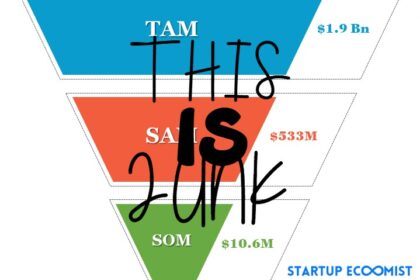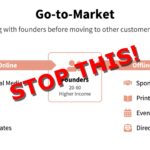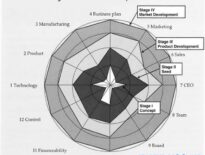
Every pitch deck has it. Every investor rolls their eyes at it. It’s that pastel-colored inverted pyramid labeled TAM, SAM, SOM, stuffed with fake numbers you copied from a McKinsey PDF you didn’t read.
If your “market slide” claims your startup is chasing a $300 billion opportunity, congratulations, you just told investors you don’t know what business you’re in.
I’ve already explained how your competition slide makes you look like a moron and why your go-to-market slide usually proves you have no go-to-market. So now let’s talk about the slide that most reliably destroys your credibility before you’ve said a word: your Total Addressable Market.
Because here’s the thing: TAM/SAM/SOM isn’t a math exercise, it’s a reasoning test. It’s not about “how big” your market is; it’s about whether you understand what your market is and how you’ll capture it.
Article Highlights
Let’s Fix Startups’ TAM/SAM/SOM, Starting From the Bottom
1. Serviceable Obtainable Market (SOM): The Market You Can Actually Get, Right Now
Your Serviceable Obtainable Market is not your dream. It’s your reality.
Think of SOM as your “as-is” potential; the market you can credibly win with your current team, your current product, and zero new funding. It’s not the ceiling; it’s your first step.
If you’re a B2B SaaS startup serving dental clinics, your SOM isn’t “the global dental industry.” It’s the subset of practices in your region that you can realistically reach with your existing marketing budget, without hiring anyone new. Maybe that’s 500 clinics. Maybe it’s 50. The point isn’t the number, it’s that you can prove you can execute against it.
This is what shows investors you’re disciplined. It says, “We know what we can do now and we’re doing it.”
If you can’t define this without hand-waving, you don’t have a business model. You have a brochure.
2. Serviceable Addressable Market (SAM): The Market You Could Get With Capital
Here’s where you lose the point. The Serviceable Addressable Market isn’t your “target audience.” It’s the market you can reach if you raise money and invest it intelligently.
This is your why slide for the raise. It’s where you show that the infusion of capital will directly expand your accessible market.
For example: if your SOM is “500 dental clinics in Texas,” your SAM might be “5,000 clinics nationwide,” because you’ll use the capital to hire sales reps, build integrations, or fund ads that make national marketing viable.
The SAM should show a clear, rational multiplier on your SOM, and a believable plan for how the new resources get you there.
This is how investors calculate ROI. If they put in $2M, and that extends your reach from $2M ARR potential to $20M, that’s a story. But if your SAM slide just says, “Next, we’ll expand globally,” you’ve said nothing. You’re just waving at a globe. And remember, if your Go To Market slide is junk because you don’t actually know how, this is rather moot.
3. Total Addressable Market (TAM): The Market You Could Own, If It All Works
Now, your Total Addressable Market is not “everyone with a pulse.” It’s the logical extension of your current focus!
If your SOM is Texas dental clinics and your SAM is U.S. dental clinics, your TAM might be all clinics in allied verticals that your same platform could serve if you expand functionality: orthodontists, optometrists, veterinarians, maybe even med spas.
This shows the upside potential of your model while demonstrating that you know how to niche down.
TAM is not about “how big the industry is.” It’s about how big your obtainable opportunity could be if you successfully replicate your model into the next logical market segment.
For early-stage startups, that’s how investors think about 15x potential; not because the whole world will buy your product, but because you can move from one niche to the next, with capital and competence.
How to Actually Calculate These Numbers (Without Lying)
Forget Googling “industry size.” That’s where founders go to die. AI can do this for you more accurately but even then you likely need a Marketing Advisor (at least, if not someone on the team) who knows how to craft the prompts relative to marketing profiles, acquisition plans, and that effective Go To Market strategy.
Start from the bottom up, not the top down.
- SOM: Count actual prospects. List every customer you could realistically sell to today. Estimate revenue per customer, multiply, done.
Example: 500 clinics × $400/month = $2.4M SOM. - SAM: Expand the radius. What’s the next step once you have funding, more geographies, a related vertical, a larger customer type?
Example: 5,000 clinics × $400/month = $24M SAM. - TAM: Project your product roadmap outward. What adjacent segments could your model serve?
Example: 75,000 total healthcare practices × $400/month = $360M TAM.
Notice how these numbers build on each other, instead of being random data points from different universes. That’s what credible investors look for: a logical staircase, not a delusional data dump without a valid plan.
What to Put on the Slide (and What to Ditch)
Throw away that pyramid. It’s lazy.
Instead, show your market as a series of concentric circles or a ladder, with a short sentence under each tier explaining:
- What defines this market segment
- What resources are required to reach it
- What milestones prove you’re ready to move up
Then include two lines at the bottom:
“Here’s what we can achieve now.”
“Here’s what your investment enables next.”
That’s the conversation investors actually want to have.
Then What? This is Where You Sizzle
Once you’ve explained your SOM, SAM, and TAM properly, your next slide should answer, “Then what?”
If you’re raising $2M to reach your SAM, what do you expect to achieve (revenue, users, partnerships) that position you to move toward the TAM?
Show the domino effect: the next feature unlocks the next market, which unlocks the next revenue stream.
That’s not just market sizing, it’s strategic sequencing. It’s what separates the startups that are thinking like businesses from the ones just making pretty slides.
The Real Point of the TAM/SAM/SOM Slide
You’re not trying to impress investors with big numbers. You’re trying to convince them you’re not delusional – you’re showing that you know what you’re doing and they’re not wasting money on someone who will use their money to figure it out as you go.
Your market slide is where you prove that you’ve thought through focus, scalability, and capital efficiency.
Investors don’t need to know that your market is worth $300B. They need to know that your first $3M is achievable, your next $30M is logical, and your next $300M is plausible.
Do that, and suddenly your TAM/SAM/SOM isn’t just a slide, it’s your whole business model, condensed into one chart.
If this feels like déjà vu, it should. First, you screwed up your competition slide. Then, your go-to-market was a slogan full of SEM, PR, and Trade Shows, not a strategy. Now your market sizing is a fantasy novel.
At some point, founders need to realize: the goal isn’t to pitch bigger, it’s to think smaller, better, and smarter.
Because the startups that master focus are the ones that get funded. The ones that get funded? They’re the ones investors can actually believe.




It’s about demonstrating market comprehension
Ding ding ding ding!
Give that man some reddit karma
And, in fairness to founders, this is why you need *someone* who knows how to do that.
not only well said but spot on with good detail. Now if only ….. following directions is the key.
Amy C. I’m thinking of calling my series, “Stop listening to the advisor who doesn’t know what they’re doing”
I can’t tell you how many times I’ve seen slides saying “the market is infinte and we’ll capture 50% of it! (but only if you give us more money than is reasonably justified)”
The one that bugs me is the Billion-dollar market TAM. Well, no kidding, if this works throughout the world, of course it’s that big. Now, tell me what’s likely.
I so much love this as this truly represents our pitch deck model before market entry and now with 9 months into operations, it clearly gives much confidence in pitching to Investors as there is clear pathway for growth with enough capital injection.
Thanks so much for putting thiz information out there as its both refreshing and insightful.
That TAM/SAM/SOM breakdown is absolutely right, and it reveals the deeper problem underneath our startup economy.
Founders don’t just “misunderstand” their markets.
They’re trapped inside investor frameworks that were never built to measure human infrastructure; belonging, safety, and cognitive bandwidth.
Every slide deck assumes a functioning operator, a healthy founder, and a stable team.
But what happens when the system itself erodes those conditions?
The market pyramid can’t just represent opportunity anymore.
It has to represent readiness; not of a product, but of the people sustaining it. That’s where Market Architects come in.
Business Builders optimize execution inside old frameworks.
Market Architects rebuild the frameworks themselves; like embedding “Cognitive Safety First” so survival and execution can actually follow. In this next era, the biggest TAM isn’t technology. It’s human capacity restored. Remember humans? They’re a silent majority share of the equations but aren’t being factored in AT ALL. YET.
I coach people on the economics of the fund, and why the allocator of any fund over $100M *has* to see them as having a billion dollar exit, but that’s not the same as “we’re creating a billion dollar market”
Love this!
Thank you Nishi. Too few appreciate how EVERY slide in a pitch deck relates to the others.
Texas MS in Technology Commercialization (MSTC)Texas McCombs School of Business Check this out– some of the best advice you can get on this. Know your markets!
Tim Hayden the number of conversations I’ve been having about fixing Commercialization Offices is both astounding and heart warming. Excited we’re fixing some
Adding Barrett Ann Pearce, MSTC at Stanford’s StartX here as well! There is huge disconnect between the academics and the practice. We can start there–put in the work!